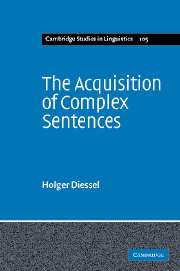Book contents
- Front matter
- Contents
- Figures
- Tables
- Acknowledgements
- Abbreviations
- 1 Introduction
- 2 A dynamic network model of grammatical constructions
- 3 Towards a definition of complex sentences and subordinate clauses
- 4 Infinitival and participial complement constructions
- 5 Complement clauses
- 6 Relative clauses
- 7 Adverbial and co-ordinate clauses
- 8 Conclusion
- Appendix
- References
- Author index
- Subject index
4 - Infinitival and participial complement constructions
Published online by Cambridge University Press: 22 September 2009
- Front matter
- Contents
- Figures
- Tables
- Acknowledgements
- Abbreviations
- 1 Introduction
- 2 A dynamic network model of grammatical constructions
- 3 Towards a definition of complex sentences and subordinate clauses
- 4 Infinitival and participial complement constructions
- 5 Complement clauses
- 6 Relative clauses
- 7 Adverbial and co-ordinate clauses
- 8 Conclusion
- Appendix
- References
- Author index
- Subject index
Summary
The earliest multiple-clause utterances that all five children produce include a finite verb and an infinitive that one might analyse as a nonfinite complement clause (e.g. I wanna eat). The occurrence of these constructions is initially restricted to a small number of complement-taking verbs such as want, have, and like that indicate volition or obligation. The present chapter shows that, although these verbs behave grammatically like matrix verbs, semantically they function like modals: rather than denoting an independent state of affairs, they indicate the child's desire or obligation to perform the activity denoted by the nonfinite verb. The whole utterance contains a single proposition and thus does not involve embedding. Other early infinitival and participial complements occur with aspectual verbs such as start and stop. Like the early quasi-modals, the aspectual verbs do not make reference to an independent state of affairs; rather, they elaborate the temporal structure of the activity denoted by the nonfinite verb. As children grow older, these constructions become increasingly more complex. Many of the complement-taking verbs that emerge later describe activities that are semantically more independent of the nonfinite verb than the early quasi-modals and aspectual verbs. Moreover, while children's early nonfinite complement clauses are always controlled by the matrix clause subject (e.g. I wanna sing), later nonfinite complements are often controlled by the direct object, which occurs between the finite verb and the infinitive or participle (e.g. He told him to leave).
- Type
- Chapter
- Information
- The Acquisition of Complex Sentences , pp. 49 - 76Publisher: Cambridge University PressPrint publication year: 2004



